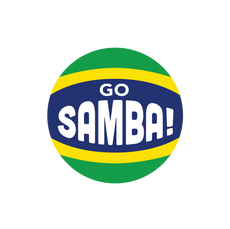This is a quick overview of the role of the surdo in a bateria. I will explain the drum sizes, patterns played, and the mallets straps typically used when playing surdos.
The surdo is the the deep bassy heartbeat of samba. Their essential function is to mark the time for the bateria and dancers. But their effect on the ensemble is massive. A good surdo crew fills the samba with life and energy, but will also hold it down if things start to rush and speed up.
The first samba drum you hear as a bateria approaches from a distance is the surdo. These are the biggest and deepest pitched drums of the ensemble.
Three surdo sizes
Generally samba groups use 3 sizes of surdos. The "primera" or first surdo is the biggest drum with the lowest pitch. The "segunda" or second surdo, is the middle sized with the middle pitch. And the smallest is the "terceira" or third surdo with the highest pitch.
The segunda is also called the "resposta" or response. The segunda responds to the primera.
Primera and segunda, keeping time
Primeras and segundas mark the time. Most N. Americans count samba music in 4/4. So, with batucada styles we can think of the primeras as playing on beats 2 and 4. And we can think of segundas as playing on beats 1 and 3.
The terceira plays syncopated and some improvised rhythms over the top of the primera and segunda, with emphasis on beats 2 and 4. These rhythms along with the caixa rhythms can be specific to each samba school. A trained ear can tell which bateria is playing just by hearing the caixa pattern and/or terceira!
A typical terceira pattern:

Terceira can also function as a time keeper alone playing a swung pattern called "pedal". Often this is done at the beginning of a samba enredo when it is just the singer and stringed instruments performing. The hits on the beat are muted with the hand. The pedal pattern looks like this:

Outliers
Mocidade Independente de Padre Miguel are notable exceptions to this, they have these reversed their primeras and segundas. Primeras are playing on 1 and 3, segundas are playing on 2 and 4.
São Clemente used to also do this until 2015 when they switched to the way most other schools play.
Mangueira throws all of this out the window. They only use 2 surdos. The lower pitched surdos play on 2 and 4. They do not have a surdo playing on 1 and 3. They also use a higher pitched surdo mor, which plays a completely different 2 bar phrase.
Mangueira's surdo mor pattern:

Bahia
For music from Bahia the primeras can play on 2 and 4 or 1 and 3. And segunda will, of course play opposite. Some people will swear that in Bahia they will only play primeras on 1 and 3, but just listen to some Ilê Aiyê CDs and you'll quickly hear that this is not always true.
In batucada, Rio style samba, surdo mallets have a hard bead head, covered in felt. The hard bead adds a lot of attack to the sound but the felt keeps it from sounding "slappy".
In Bahia, samba reggae and samba afro styles the mallet heads are a little softer. Sounding more like a deep thud.
In Rio shoulder straps are all the rage! It's not like every single person uses shoulder straps but they are very common. The drum then hangs off the body at an angle. Which makes it really handy to wallop the snot out of it with your strong hand.


In Bahian styles players tend to prefer the waist strap and the drum hangs more straight. Often the drum is slung low and hangs between the knees.


Outliers
There is a short fat surdo called a bumbo. The head diameter is 22 inches, and the shell is about one foot deep. They're usually played as a primera. I have not played one of these but I bet it's a lot easier on the knees than the traditional deeper surdos.
Conclusion
This has been your very quick overview of the surdo's role in samba. Many newbies to samba mistakenly think the surdo is an easy and boring drum to play. But the surdo carries so much responsibility to the group, and can have so much control over the group's sound, energy, and pulse that higher level groups only allow experienced veterans to play surdos.
The surdos will drive the energy and personality of the group to a huge extent. If the surdo players are unsure or not mentally present this reflected in the sound of the entire group. Everyone can feel it and the sound comes off as lame and boring.
Playing surdo well, is a meditation. This instrument deserves respect among all sambistas.
Surdos for sale on the site can be found here. Surdos for Sale
This music is alive and constantly changing. Just because a "fact" is stated here, or you hear an expert state a "fact", does not mean that it is true everywhere for every circumstance. All living and healthy art forms, like all living and healthy people tend to breathe, grow, and change.


Leave a comment